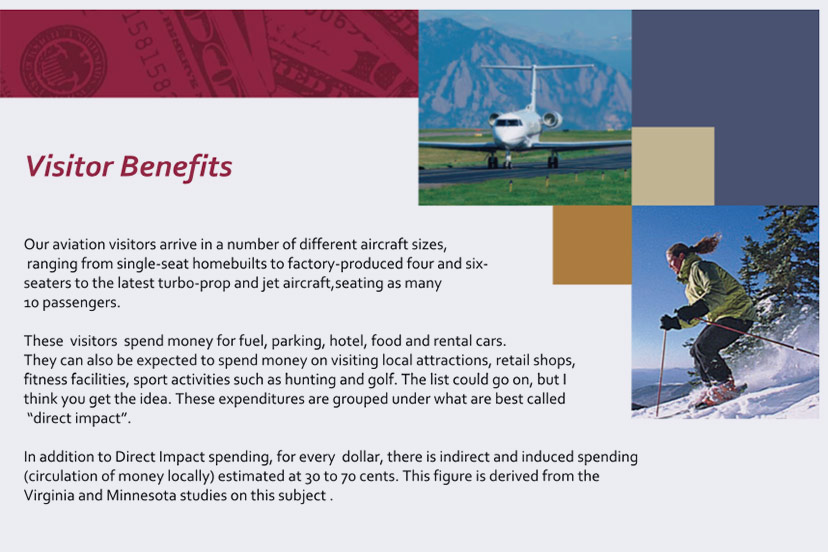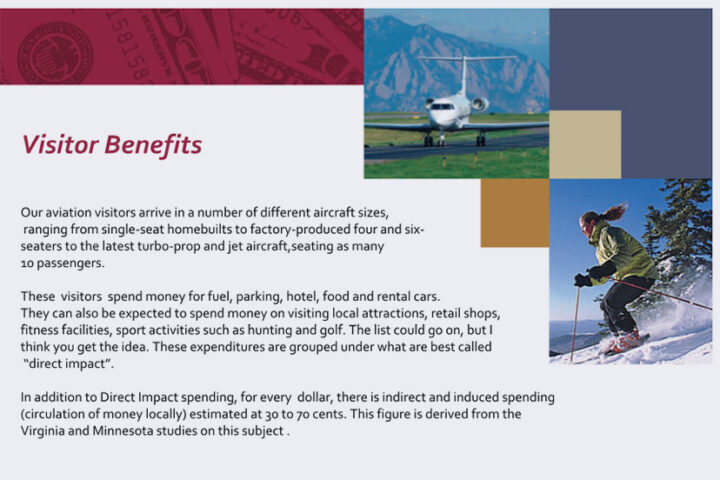What is the economic impact of the Archuleta County-owned airport on Piedra Road? How would the impact be calculated, if we were being scrupulous and ethical about making that measurement?
We understand — without needing the help of computerized data — some of the negative aspects of the expansion of Stevens Field that have taken place over the past decade. Especially, the neighborhood around East and West Golf Place has experienced the noise from increased private jet traffic. And although it’s harder to determine than the sound of a jet taking off, the allocation of millions of tax dollars to airport expansion and maintenance has reduced the amount of funding available for other County needs (such as road maintenance for those of us who travel via automobile.)
We will note that an Economic Impact Study (EIS) is a different animal from an Environmental Impact Statement (EIS). An Environmental Impact Statement is an attempt to research, and share publicly, the overall impacts of a proposed government decision, including the impacts on water, air, land, wildlife, and society. Typically, an Environmental Impact Statement (EIS) requires the relevant government agency to solicit input from the public. The intention here is to collect a wide variety of viewpoints, on a wide variety of impacts.
An Economic Impact Study has a very different goal — as I understand it, based on the 2012 EIS produced by the Archuleta County Airport Advisory Commission. The apparent aim of the 2012 Economic Impact Study for Stevens Field was to justify and encourage the expenditure of public funds on a facility used by very few residents and visitors, by making a claim that the facility generates significant economic benefits for the entire community.
For example. One claim might be that the owners of private jets and smaller planes spend a great deal of money building expensive homes in Archuleta County, and also, that the aviation community spends money building and maintaining airplane hangers. And that airplane owners spend money in the community.
From the 2012 Airport EIS (which you can download here):
The following data represents only those 43 respondents for the period from 2002 to 2011:
The total investment by the aviation community in homes including taxes paid = $27,820,000.
The total investment in hangars including taxes paid = $ 2,940,000
The total contribution to the local merchants for commodities = $9,141,630
Overall contribution to Archuleta County by aviation community for 10 years = $39,901,630
The EIS also claimed can that Stevens Field is vital to the tourism industry.
Our aviation visitors arrive in a number of different aircraft sizes, ranging from single-seat homebuilts to factory-produced four and six seaters, to the latest turbo-prop and jet aircraft, seating as many as 10 passengers.
Not that it has anything to do with this conversation, but I used to own a mini-van that could seat 8 people.
These visitors spend money for fuel, parking, hotel, food and rental cars. They can also be expected to spend money on visiting local attractions, retail shops, fitness facilities, sport activities such as hunting and golf. The list could go on, but I think you get the idea…
One of the devices used by analysts who want to justify government expenditures based on ‘economic benefits’ is to claim ‘indirect and induced spending.’ This is a real phenomenon, but one which (in my humble opinion) is impossible to quantify accurately.
When a family arrives in Archuleta County in a private jet — perhaps, from Texas — we can assume, for example, that they will eat dinner at least once at the Alley House Grille. When they pay for their dinner, the Alley House will use some of the money to pay its employees and investors. One of the Alley House employees might then use some of the money to fill their shopping cart at City Market, and City Market would then use a portion of that money to pay its employees and investors. Then, one of the City Market employees might use the money buy a six-pack at a nearby liquor store…
The list could go on, but you get the idea.
In this way, a certain amount of money brought into Archuleta County from Texas will have a chance to circulate, and re-circulate, within the community, thus making the economic impact appear more substantial than the initial expenditure at the Alley House Grille.
When the main author of the 2012 Economic Impact Study — who, as I recall, was Airport Advisory Commission member Michael Arbuthnot — added up all of the economic spending by pilots and jet plane owners on homes, taxes, direct spending, and indirect spending, he calculated that the aviation community — residents and visitors — had contributed about $51 million in economic benefits between 2002 and 2011.
During that same period, he calculated, local taxpayers had contributed about $1.1 million to subsidize the County Airport’s everyday operations.
But that was not the only taxpayer expense.
In addition to our Airport Improvement Programs above, in 2005 Archuleta County invested $4,400,000 in a State of the Art Airport Operation hangar facility, 10 private hangars and taxiway resurfacing. This significant and forward thinking investment demonstrated the commitment of Archuleta County to support an airport and was a prerequisite to receiving the capital funds from the Federal and State Airport Grant Programs. Although this cost was born by Archuleta County alone, it opened the door for us to receive many millions of dollars of Federal and State funds.
The Fixed Base Operations hangar facility incurred a debt cost for 10 years at $353,000 annually and will be paid off in late 2014. At that time Archuleta County Airport will own a beautiful operations facility which is second to none, and which will serve our visitors well into the future.
The bottom line conclusion:
For every dollar Archuleta County invests in the airport, the County receives a return of $10.86.
I believe the author meant to say, “the community receives a return of $10.86″ I don’t see, in the study, evidence that the Archuleta County government, as a whole, receives a positive financial benefit from the Airport. On the contrary, it would appear that, between 2002 and 2011, the Archuleta County government spent about $5.5 million in local taxpayer revenues at Stevens Field, subsidizing the owners of airplanes.
What does the future look like?


